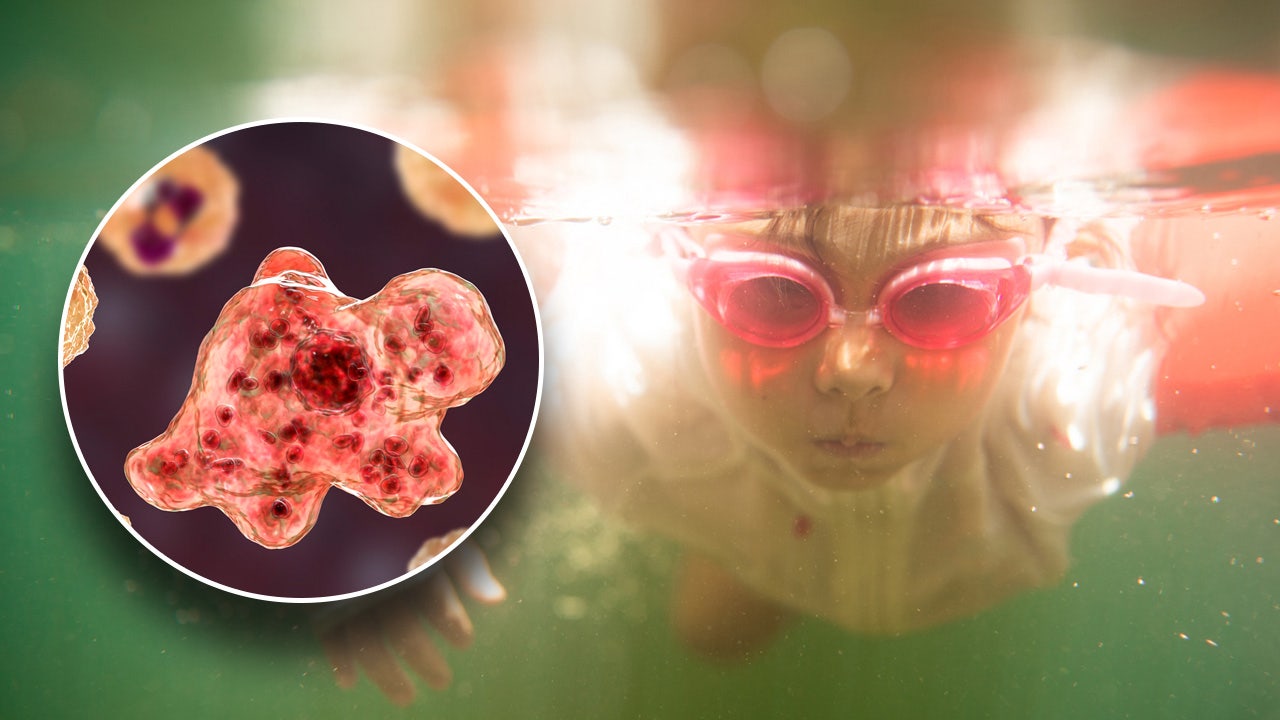Health
Brain-eating amoebas: What you must know about the risk of swimming in fresh water

Cooling off in lakes, rivers and streams is a hallmark of the summer — but for an unlucky few, it can lead to an infection caused by Nagleria fowleri, a bacteria more commonly known as the brain-eating amoeba.
In the U.S., there have been at least three reported deaths this year from the infection, which occurs when the bacteria enter the nose during submersion in fresh water, usually while swimming.
Nagleria fowleri can cause the deadly primary amebic meningoencephalitis (PAM), which destroys brain tissue, according to the CDC.
GEORGIA TEEN GIRL IDENTIFIED AS RESIDENT WHO DIED OF BRAIN-EATING AMOEBA AFTER SWIMMING IN LAKE
Of the 157 people known to be infected in the U.S. between 1962 and 2022, only four individuals survived — meaning the death rate is more than 97%.
In late July, a 17-year-old Georgia girl, Morgan Ebenroth, died after becoming infected with the bacteria while swimming in a lake with friends.
Morgan Ebenroth, 17, of Georgia died after she became infected with the bacteria while swimming in a lake with friends. (Megan Ebenroth Instagram)
Also in July, the Nevada Division of Public and Behavioral Health (DPBH) reported that a 2-year-old boy died after contracting a brain-eating amoeba infection from a natural hot spring.
And in February, a Florida man died after he was infected when washing his face and rinsing his sinuses with tap water containing Nagleria fowleri.
Fox News Digital spoke with Tammy Lundstrom, chief medical officer and infectious disease specialist for Trinity Health in Michigan, about the risks and the prevention of infection.

In the U.S., there have been at least three reported deaths this year from the brain-eating amoeba, which enters the nose during submersion in fresh water, usually while swimming. (iStock)
“The risk of brain-eating amoeba is very low,” she said. “Fewer than 10 people in the U.S. every year get infected — but unfortunately most cases are fatal. There are only a handful of survivors of known cases.”
Hotspots of infection
The Southern U.S., with its warmer temperatures, has reported the most cases — 157 in total between 1962 and 2022, Lundstrom said.
Almost half of these occurred in Texas and Florida.
July, August and September are the highest-risk months.
“However, there are a few even rarer cases reported from the northern states,” she said.
FLORIDA RESIDENTS WARNED ABOUT TAP WATER AFTER MAN DIES FROM BRAIN-EATING AMOEBA
The amoeba only lives in freshwater, so swimming in the ocean is not a risk, Lundstrom added.
Naegleria fowleri thrives in warm water, growing best at temperatures up to 115°F. This means that July, August and September are the highest-risk months, according to the CDC’s website.
Some experts believe that climate change could make Naegleria fowleri infections more common.

A 3D illustration shows a cerebrospinal fluid smear containing trophozoites of the brain-eating amoeba Naegleria fowleri. (iStock)
“As air temperatures rise, water temperatures in lakes and ponds also rise and water levels may be lower,” the CDC’s website states.
“These conditions provide a more favorable environment for the amoeba to grow.”
It also says, “Heat waves, when air and water temperatures may be higher than usual, may also allow the amebae to thrive.”
Warning signs to know
The initial symptoms of PAM usually begin about five days after exposure to the bacteria — but they can be noticed sooner.
Early signs usually include headache, nausea, fever and/or vomiting, per the CDC.
“Millions of people enjoy swimming every summer, but only a few become infected.”
As the infection progresses, people may experience confusion, stiff neck, disorientation, hallucinations, seizures and coma.
COVID HOSPITALIZATIONS ARE ON THE RISE, COULD SIGNAL ‘LATE SUMMER WAVE,’ SAYS CDC
“People usually start to feel ill one to 12 days after the water exposure,” Lundstrom said. “Early symptoms should prompt a medical evaluation, as they are also signs of bacterial meningitis.”
Death can occur anywhere between one and 18 days of infection, with an average of five days.
Prevention of infection
The best way to prevent infection is to avoid putting your head in the water when swimming, Lundstrom told Fox News Digital.

Those who experience sudden headache, fever, stiff neck or vomiting — especially if they’ve recently been swimming in warm freshwater — should seek immediate medical attention. (iStock)
“Infection occurs when water harboring the amoeba goes up a person’s nose, usually during swimming,” she said.
“It is not known why some people get infected and others, even swimming companions, do not.”
Drinking contaminated water does not cause infection, and it does not spread from one person to another, Lundstrom added.
DANGERS YOU CAN’T SEE MAY BE LURKING IN YOUR UNWASHED BEDDING, SAYS STUDY: BEWARE THE ‘HEALTH CONCERNS’
Although a death was reported this year after a man was exposed to the bacteria while washing his face and clearing his sinuses with tap water, Lundstrom said this is a remote risk.
“The best protection would be to avoid immersing your head when swimming in the summer.”
People can also use nose clips or hold the nose shut to prevent infection.
Because the bacteria is found in soil, the CDC also recommends avoiding stirring up the sediment at the bottom of lakes, ponds and rivers.
Treatment of brain-eating amoebas
When a patient has been diagnosed with a brain-eating amoeba, treatment usually includes a variety of anti-fungal medications, including rifampin and azithromycin, Lundstrom said.
Miltefosine, a newer anti-fungal drug, has been shown to kill the bacteria in laboratory tests and was used to treat three of the surviving patients, the CDC states on its website.

When a patient has been diagnosed with brain-eating amoeba, treatment usually includes a variety of anti-fungal medications, including rifampin and azithromycin. (Martin Barraud via Getty Images)
“However, the effect of all of these drugs on actual infected people is unknown due to the high fatality rate,” Lundstrom noted.
CLICK HERE TO SIGN UP FOR OUR HEALTH NEWSLETTER
Those who experience sudden headache, fever, stiff neck or vomiting — especially if they have recently been swimming in warm freshwater — should seek immediate medical attention, the CDC recommends.
Despite the infection’s high fatality rate, Lundstrom emphasized the rarity of cases.
“Millions of people enjoy swimming every summer, but only a few become infected,” she said.
“The best protection would be to avoid immersing your head when swimming in the summer.”

Health
Kennedy’s Plan for the Drug Crisis: A Network of ‘Healing Farms’

Though Mr. Kennedy’s embrace of recovery farms may be novel, the concept stretches back almost a century. In 1935, the government opened the United States Narcotic Farm in Lexington, Ky., to research and treat addiction. Over the years, residents included Chet Baker and William S. Burroughs (who portrayed the institution in his novel, “Junkie: Confessions of an Unredeemed Drug Addict”). The program had high relapse rates and was tainted by drug experiments on human subjects. By 1975, as local treatment centers began to proliferate around the country, the program closed.
In America, therapeutic communities for addiction treatment became popular in the 1960s and ’70s. Some, like Synanon, became notorious for cultlike, abusive environments. There are now perhaps 3,000 worldwide, researchers estimate, including one that Mr. Kennedy has also praised — San Patrignano, an Italian program whose centerpiece is a highly regarded bakery, staffed by residents.
“If we do go down the road of large government-funded therapeutic communities, I’d want to see some oversight to ensure they live up to modern standards,” said Dr. Sabet, who is now president of the Foundation for Drug Policy Solutions. “We should get rid of the false dichotomy, too, between these approaches and medications, since we know they can work together for some people.”
Should Mr. Kennedy be confirmed, his authority to establish healing farms would be uncertain. Building federal treatment farms in “depressed rural areas,” as he said in his documentary, presumably on public land, would hit political and legal roadblocks. Fully legalizing and taxing cannabis to pay for the farms would require congressional action.
In the concluding moments of the documentary, Mr. Kennedy invoked Carl Jung, the Swiss psychiatrist whose views on spirituality influenced Alcoholics Anonymous. Dr. Jung, he said, felt that “people who believed in God got better faster and that their recovery was more durable and enduring than people who didn’t.”
Health
Children exposed to higher fluoride levels found to have lower IQs, study reveals

The debate about the benefits and risks of fluoride is ongoing, as RFK Jr. — incoming President Trump’s pick for HHS secretary — pushes to remove it from the U.S. water supply.
“Fluoride is an industrial waste associated with arthritis, bone fractures, bone cancer, IQ loss, neurodevelopmental disorders and thyroid disease,” RFK wrote in a post on X in November.
A new study published in JAMA Pediatrics on Jan. 6 found another correlation between fluoride exposure and children’s IQs.
RFK JR. CALLS FOR REMOVAL OF FLUORIDE FROM DRINKING WATER, SPARKING DEBATE
Study co-author Kyla Taylor, PhD, who is based in North Carolina, noted that fluoridated water has been used “for decades” to reduce dental cavities and improve oral health.
Fluoride exposure has been linked to a variety of negative health effects, yet benefits oral health. (iStock)
“However, there is concern that pregnant women and children are getting fluoride from many sources, including drinking water, water-added foods and beverages, teas, toothpaste, floss and mouthwash, and that their total fluoride exposure is too high and may affect fetal, infant and child neurodevelopment,” she told Fox News Digital.
The new research, led by scientists at the National Institute of Environmental Health Sciences (NIEHS), analyzed 74 epidemiological studies on children’s IQ and fluoride exposure.
FEDERAL JUDGE ORDERS EPA FURTHER REGULATE FLUORIDE IN DRINKING WATER DUE TO CONCERNS OVER LOWERED IQ IN KIDS
The studies measured fluoride in drinking water and urine across 10 countries, including Canada, China, Denmark, India, Iran, Mexico, Pakistan, New Zealand, Spain and Taiwan. (None were conducted in the U.S.)
The meta-analysis found a “statistically significant association” between higher fluoride exposure and lower children’s IQ scores, according to Taylor.
“[It showed] that the more fluoride a child is exposed to, the more likely that child’s IQ will be lower than if they were not exposed,” she said.

Scientists found a “statistically significant association” between higher fluoride exposure and lower children’s IQ scores. (iStock)
These results were consistent with six previous meta-analyses, all of which reported the same “statistically significant inverse associations” between fluoride exposure and children’s IQs, Taylor emphasized.
The research found that for every 1mg/L increase in urinary fluoride, there was a 1.63-point decrease in IQ.
‘Safe’ exposure levels
The World Health Organization (WHO) has established 1.5mg/L as the “upper safe limit” of fluoride in drinking water.
“There is concern that pregnant women and children are getting fluoride from many sources.”
Meanwhile, the U.S. Public Health Service recommends a fluoride concentration of 0.7 mg/L in drinking water.
“There was not enough data to determine if 0.7 mg/L of fluoride exposure in drinking water affected children’s IQs,” Taylor noted.
FDA BANS RED FOOD DYE DUE TO POTENTIAL CANCER RISK
Higher levels of the chemical can be found in wells and community water serving nearly three million people in the U.S., the researcher noted.
She encouraged pregnant women and parents of small children to be mindful of their total fluoride intake.

Nearly three million people have access to wells and community water with fluoride levels above the levels suggested by the World Health Organization. (iStock)
“If their water is fluoridated, they may wish to replace tap water with low-fluoride bottled water, like purified water, and limit exposure from other sources, such as dental products or black tea,” she said.
“Parents can use low-fluoride bottled water to mix with powdered infant formula and limit use of fluoridated toothpaste by young children.”
For more Health articles, visit www.foxnews.com/health.
While the research did not intend to address broader public health implications of water fluoridation in the U.S., Taylor suggested that the findings could help inform future research into the impact of fluoride on children’s health.
Dental health expert shares cautions
In response to this study and other previous research, Dr. Ellie Phillips, DDS, an oral health educator based in Austin, Texas, told Fox News Digital that she does not support water fluoridation.

The study researcher encouraged parents of small children to be mindful of their total fluoride intake. (iStock)
“I join those who vehemently oppose public water fluoridation, and I question why our water supplies are still fluoridated in the 21st century,” she wrote in an email.
“There are non-fluoridated cities and countries where the public enjoy high levels of oral health, which in some cases appear better than those that are fluoridated.”
CLICK HERE TO SIGN UP FOR OUR HEALTH NEWSLETTER
Phillips called the fluoride debate “confusing” even among dentists, as the American Dental Association (ADA) advocates for fluoride use for cavity prevention through water fluoridation, toothpaste and mouthwash — “sometimes in high concentrations.”

Fluoride is used in water, toothpaste and mouthwash to help prevent cavities. (iStock)
“[But] biologic (holistic) dentists generally encourage their patients to fear fluoride and avoid its use entirely, even if their teeth are ravaged by tooth decay,” she said.
“Topical fluoride is beneficial, while systemic consumption poses risks.”
Phillips encouraged the public to consider varying fluoride compounds, the effect of different concentrations and the “extreme difference” between applying fluoride topically and ingesting it.
“Topical fluoride is beneficial, while systemic consumption poses risks,” she cautioned.
“Individuals must take charge of their own oral health using natural and informed strategies.”
The study received funding from the National Institute of Environmental Health Sciences (NIEHS), the National Institutes of Health (NIH) and the Intramural Research Program.
Health
Treating Other Diseases With Ozempic? Experts Weigh In | Woman's World

Sign Up
Create a free account to access exclusive content, play games, solve puzzles, test your pop-culture knowledge and receive special offers.
Already have an account? Login
Use left and right arrow keys to navigate between menu items.
Use escape to exit the menu.
-
/cdn.vox-cdn.com/uploads/chorus_asset/file/25822586/STK169_ZUCKERBERG_MAGA_STKS491_CVIRGINIA_A.jpg)
/cdn.vox-cdn.com/uploads/chorus_asset/file/25822586/STK169_ZUCKERBERG_MAGA_STKS491_CVIRGINIA_A.jpg) Technology1 week ago
Technology1 week agoMeta is highlighting a splintering global approach to online speech
-

 Science7 days ago
Science7 days agoMetro will offer free rides in L.A. through Sunday due to fires
-
/cdn.vox-cdn.com/uploads/chorus_asset/file/23935558/acastro_STK103__01.jpg)
/cdn.vox-cdn.com/uploads/chorus_asset/file/23935558/acastro_STK103__01.jpg) Technology7 days ago
Technology7 days agoAmazon Prime will shut down its clothing try-on program
-

 News1 week ago
News1 week agoMapping the Damage From the Palisades Fire
-

 News1 week ago
News1 week agoMourners Defy Subfreezing Temperatures to Honor Jimmy Carter at the Capitol
-
/cdn.vox-cdn.com/uploads/chorus_asset/file/25826211/lorealcellbioprint.jpg)
/cdn.vox-cdn.com/uploads/chorus_asset/file/25826211/lorealcellbioprint.jpg) Technology6 days ago
Technology6 days agoL’Oréal’s new skincare gadget told me I should try retinol
-
/cdn.vox-cdn.com/uploads/chorus_asset/file/25832751/2192581677.jpg)
/cdn.vox-cdn.com/uploads/chorus_asset/file/25832751/2192581677.jpg) Technology3 days ago
Technology3 days agoSuper Bowl LIX will stream for free on Tubi
-

 Business4 days ago
Business4 days agoWhy TikTok Users Are Downloading ‘Red Note,’ the Chinese App















